Where the mountains meet the sea, the Andalusian region of southern Spain features stunning landscapes and beautiful coastlines. One hour away, tucked below the Sierra Nevada mountains, Granada offers a mix of unique architecture and rich culture, unlike any other Spanish city.
Moorish conquests centuries ago created impressive structures, and later when the Iberian peninsula was recaptured, Catholic monarchs changed the city into what it is today. Known for the Alhambra, historic cathedrals, and rich green areas, 2.5 million visitors come to Granada annually to see its magnificent sites. With the backdrop of huge snow-capped mountains, the picturesque scenery awakens the senses.
As you wander up and down cobblestone streets, you experience a mix of different cultures. Spanish flamenco music fills the city plazas and bars, and tiny shops selling colourful clothing line the passageways. The charming historic neighbourhoods add to the laid-back atmosphere. Here are the best things to do in Granada.
Contents
- Granada, Spain
- Best Tours
- 20 Things To Do In Granada
- 1- Explore The Wonders Of Alhambra
- 2- See How Royalty Lived At The Nasrid Palaces
- 3- Relax In The Beauty Of The Generalife Palace And Gardens
- 4- Discover Alcazaba
- 5- Explore The Palace Of Charles V
- 6- Enjoy The Museo De Bellas Arts
- 7- Discover The Charming Albaicín Neighbourhood
- 8- See The Sunset At Mirador De San Nicolás
- 9- Marvel At Granada Cathedral
- 10- Learn Something New At Parque De Las Ciencias
- 11- Walk Down Carrera Del Darro
- 12- Discover The Historic Arab Baths of Granada
- 13- See The Cave Houses In Sacromonte
- 14- Catch A Flamenco Show
- 15- See The Amazing Architecture of Monasterio De La Cartuja
- 16- Relax In Carmen De Los Mártires Gardens
- 17- See The Renaissance Architecture of Monasterio De San Jerónimo
- 18- Learn About Lorca At Huerta De San Vincent
- 19- Visit the Basílica De San Juan De Dios
- 20- See Street Art in Realejo ‘Jewish Quarter’
Granada, Spain
Best Tours
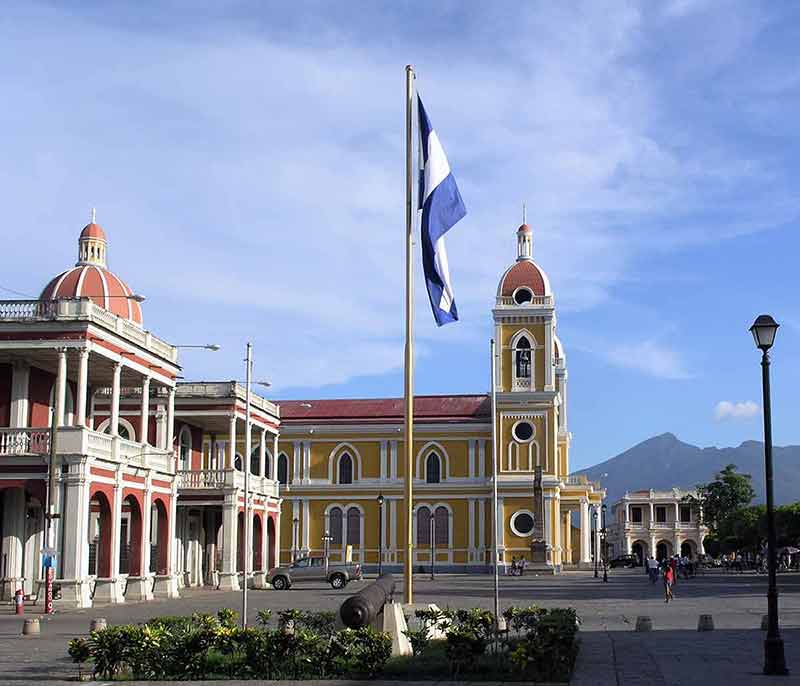
- Granada: Alhambra Skip-the-Line Tour with Nasrid Palaces – * most popular *
- Granada City Train 1 or 2-Day Hop-On Hop-Off Ticket – explore the city at your own pace.
- Granada: Los Cahorros de Monachil Canyon Hiking Tour – a guided hike exploring tunnels, bridges, waterfalls and nature.
20 Things To Do In Granada
1- Explore The Wonders Of Alhambra
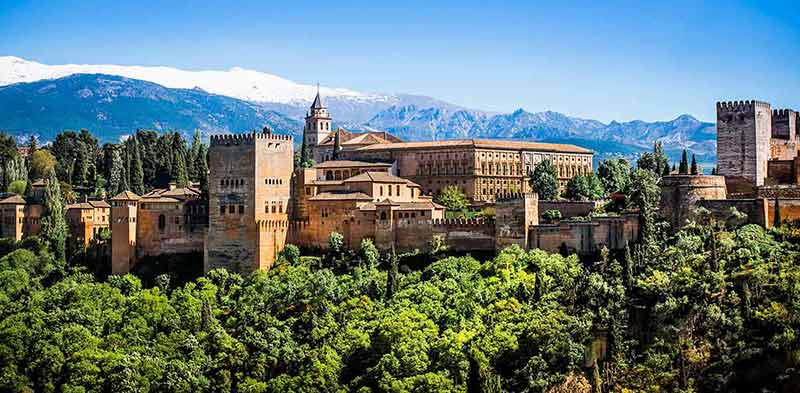
One of the most important Islamic structures ever built, the Alhambra overlooks the city in sheer dominance.
This massive fortress constructed in the 13th century served as a military defence and later housed the royal family in glory.
In Arabic, the name Alhambra means ‘red castle or vermillion’.
Inside the walls of this impressive structure are many well-preserved palaces and gardens to explore.
First references to this fortress date back to the 9th century when it was said to have been constructed under torchlight.
Later in the 13th century, it became known as the residence of the kings.
In 1492, during the reconquest of Granada, Catholic monarchs overtook Alhambra and added even more splendour to its magnificence.
Today it stands as the true iconic symbol of the city and millions of visitors come to bask in its glory each year.
Plan to spend at least a day or more in Granada’s number one attraction.
Recommended tours:
- Granada: Alhambra Skip-the-Line Tour with Nasrid Palaces
- Granada: Night Visit to the Alhambra & Nasrid Palaces
2- See How Royalty Lived At The Nasrid Palaces
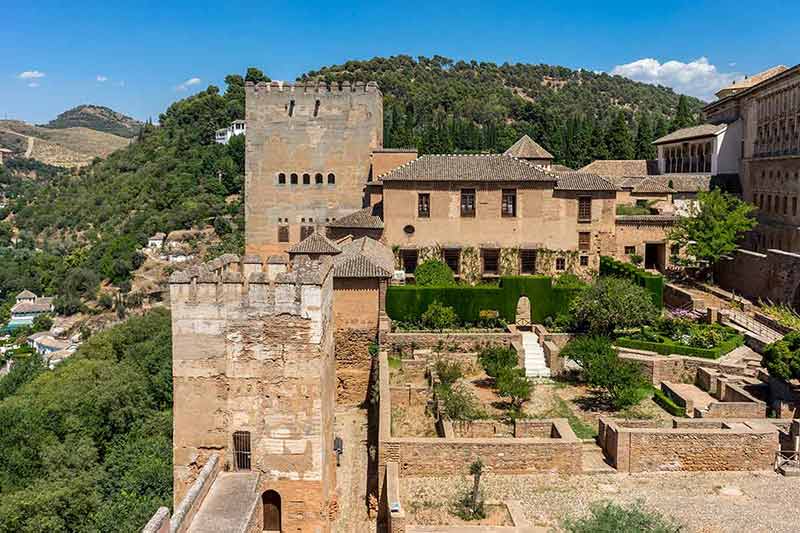
The finest example of Islamic architecture and design, the Nasrid Palaces inside the walls of the Alhambra, offers a stunning look into the life of Spanish Muslim rulers.
The kings of Granada lived in true elegance, surrounded by architectural art.
The awe-inspiring intricate designs of the walls and ceilings, preserved from the 14th century, exhibit the fantastic craftsmanship of the Muslim culture.
The rooms are perfectly symmetrical, with many thin columns at the base.
The coloured tiles are laid out in exquisite forms, bringing beauty into the halls and chambers of the interior.
The main parts of the Nasrid Palace to visit are the El Mexuar, where the meetings of the councillors took place.
The Palace of the Comares adds even more incredible architectural design.
Lion’s Palace features the royal family’s private rooms, and the Golden Room Courtyard, with its incredible gold-painted ceiling from the Catholic Kings, shows the significance of this palace in Spanish history.
Plan to spend at least three hours taking in this impressive residence of the Sultan royalty.
Visitors are limited by time slots to control the number of people inside, so plan your visit accordingly.
The Nasrid Palaces are located inside the Alhambra.
Recommended tour: Granada: Alhambra Guided Tour with Nasrid Palaces & Gardens
3- Relax In The Beauty Of The Generalife Palace And Gardens
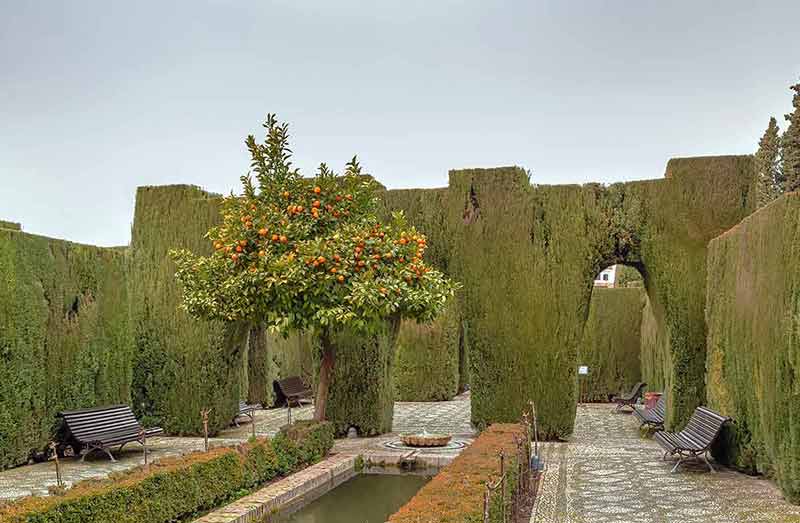
Spectacular gardens, water fountains and elegant courtyards make up the beauty of the Generalife.
Just outside of the walls of the Alhambra to the north, the Nasrid Sultans of the 13th and 14th centuries came to this place to relax and be in peace.
Generalife rests upon the hills of Cerro del Sol.
Patio de la Acequia (the main canal) just below the palace pavilion supplies water to other gardens throughout the estate.
The patio design contains both Islamic and Spanish influences.
Below you will find the Jardin de la Sultana, where, according to the legend, the wife of the last Nasrid ruler had an affair with a knight of the Abencerrajes family.
Cyprus trees surround stone fountains creating an intimate private area.
To reach the highest part of Generalife, take the Escalera del Agua.
Three flights of stone stairs come with a unique feature, water channels for handrails! Laurel trees create a canopy overhead.
Recommended tour: Granada: Alhambra, Nasrid Palaces, and Generalife Tour
4- Discover Alcazaba
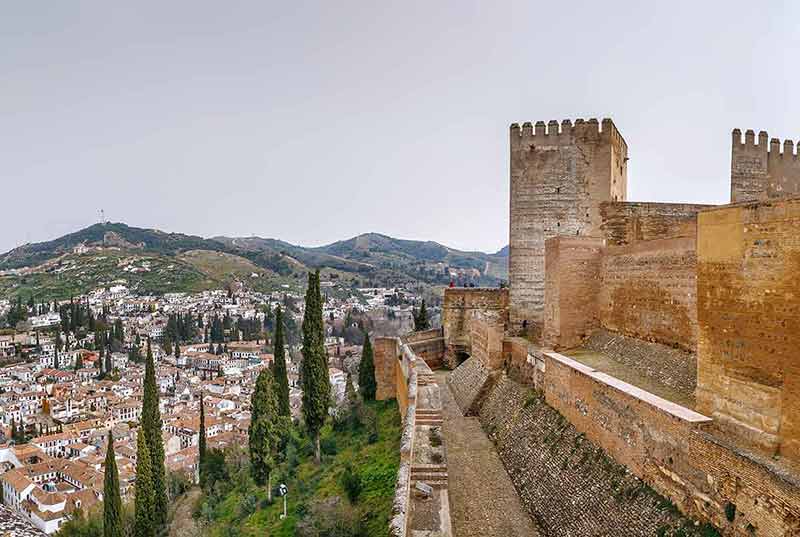
The fortress of Alcazaba reins high above the city.
As the oldest part of Alhambra, this massive structure consists of two unique parts, the lower-level fortress and the upper-level palace.
The first records referencing the structure come from the 9th century.
Its name comes from the Arabic word ‘Al-Qasaba’, which means housing the men of war.
The medieval architecture protected the Alhambra against enemy attacks and served as the residence of the Sultans and nobility.
Seeing Alhambra from any direction, the three distinct towers of Alcazaba stand out, symbolising its strength in defence.
Alcazaba was abandoned for some time and even served as a French prison.
Restoration finally came in the 20th century.
Alcazaba is located inside the Alhambra.
Recommended: Granada: Alhambra Entry Ticket with Audio Guide
5- Explore The Palace Of Charles V
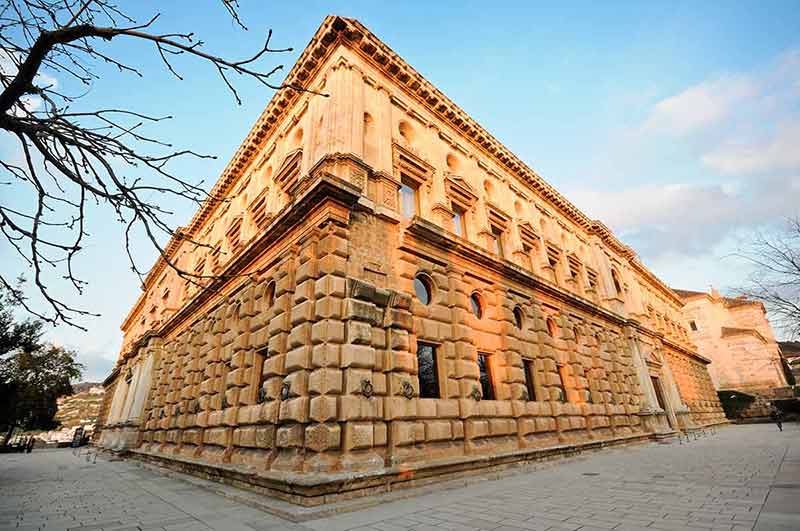
When Charles V ruled over Spain, he decided that the Alhambra did not provide an adequate residence for the comfort of the royal family.
He desired to make Granada his home, and in 1527 he commissioned a palace to be built near the Alhambra so that he could admire its beauty.
Lack of funding, the death of the original architect, war, and various other troubles complicated its completion, and in the end, he never actually lived in the palace.
This magnificent structure, constructed in the High Renaissance style, invites visitors to explore the past.
This 17-metre (56 ft) high, 63-metre (207 ft) square palace symbolises Christianity’s triumph over Islam.
The outer facade features intricate designs, while the large inner circle courtyard represents the unity between heaven and earth.
Currently, it houses two other attractions, the Museum of Alhambra and the Fine Arts Museum.
The Palace of Charles V is located at C. Real de la Alhambra, s/n, 18009 Granada.
Recommended tour: Granada City Train 1 or 2-Day Hop-On Hop-Off Ticket
6- Enjoy The Museo De Bellas Arts
If you love art, the Fine Arts Museum of Granada on the first floor of the Palace of Charles V will keep you entertained for hours.
With over 2,000 works, including paintings and sculptures, this inspiring collection captures Spanish history through art.
The museum consists of 10 rooms, set in chronological order, starting from the 15th century and ending with contemporary art.
The final room houses temporary exhibits on a rotating schedule.
Various local artists, such as Alonso Cano, Pedro Atanasio, and Juan de Sevilla, are featured here.
Much of the collection follows religious themes because many pieces were recovered from convents and monasteries.
The Museum of Fine Arts is located at C.Real de la Alhambra, s/n, 18009 Granada.
7- Discover The Charming Albaicín Neighbourhood
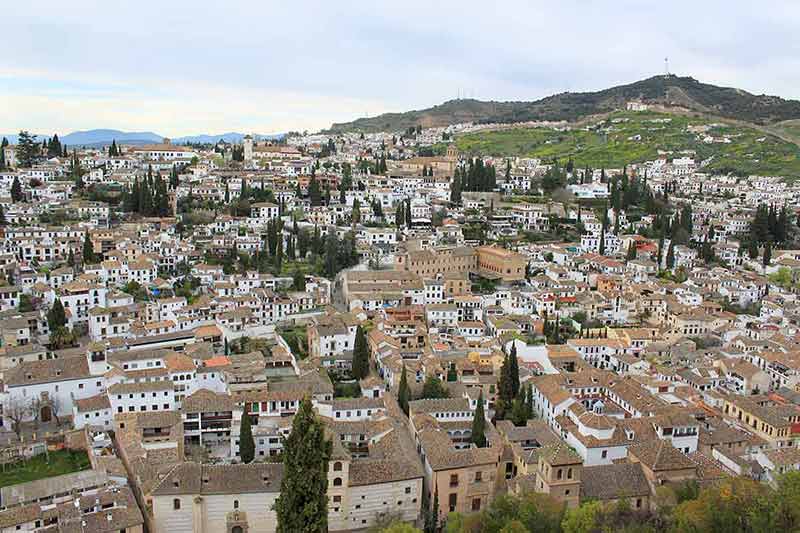
What was once referred to as the ‘Arabian Quarter’, you can feel Albaicín’s unique charm exploring its narrow winding streets.
Although many mosques and homes were destroyed during the reconquest, there are still signs of Moorish influence everywhere.
The steep climb from the city below brings you to the neighbourhood entrance at Puerto Elvira, a great place to begin your journey.
As you walk around, slight hints of Arabic architecture appear.
Explore the market area full of colourful clothing and ornaments, packed into a tiny cobblestone street.
For a good reason, UNESCO declared this area of Granada a World Heritage Site in 1984.
The most famous street in this area, Paseo de los Tristes, next to the Darro River, features spectacular views of the Alhambra from below.
When you think you’ve covered it all, head to the Mirador de San Nicolás for an incredible sunset to end your day.
Puerta de Elvira is located at Pl. del Triunfo, 19, 18010 Granada.
Recommended tour: Granada: Sunset Walking Tour in Albaicín & Sacromonte
8- See The Sunset At Mirador De San Nicolás
The absolute best views of Granada and the Alhambra come from standing at the Mirador de San Nicolás, which shares its name with the church in the square nearby.
Often referred to as the ‘The Best Sunset of all of Granada’, hundreds swarm the square to take the breathtaking views.
In 1997 Bill Clinton visited the site and proclaimed, “It was the most beautiful sunset in the world”.
The panoramic view displays the Alhambra in full view, along with the Generalife Park and the Sierra Nevada mountains in the background.
To reach this spot, go to the Albaicín neighbourhood, and walk up the Calle San Nicolás until you reach the church.
The Mirador is at Plaza Mirador de San Nicolás, 2,18010 Granada, Spain.
Recommended tours:
- Granada: Alhambra and Sierra Nevada Sunset Views by E-Bike
- From Granada: Sierra Nevada 4WD Tour
- From Granada: High Sierra Nevada 6 hours hiking experience
9- Marvel At Granada Cathedral
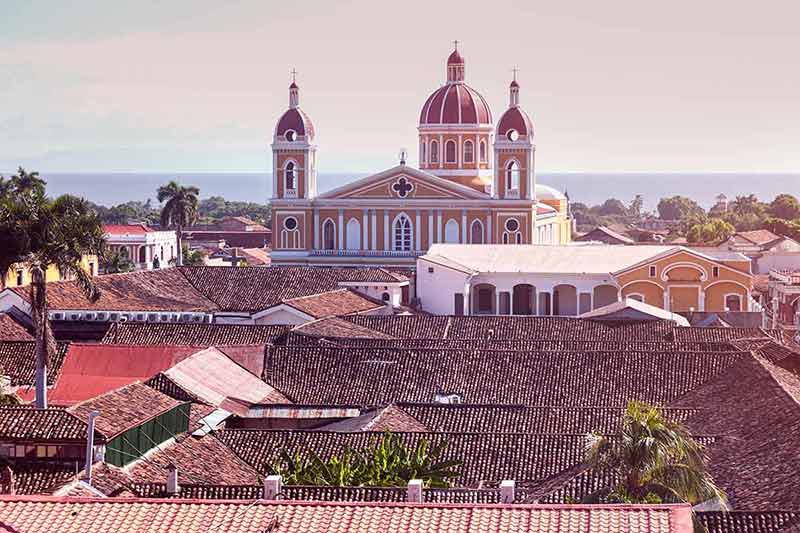
Built upon the city’s main mosque, this Roman Catholic Church, completed in 1561, boasts incredible interior decorations.
It’s the first Renaissance church constructed in Spain and one of the best examples of this type of architecture.
The columns rise high up into the ceiling providing ample light.
Marble walls contrast with checkered floors, combined with gold trim work.
Inside you will find the tombs of the catholic monarchs Fernando and Isabel.
You can learn about its interesting history and marvel at its lavish design.
Granada Cathedral is at Calle Gran Via de Colon, 5, Granada,18001.
Recommended tour: Granada: City Center, Cathedral, Capilla, and Madraza Tour
10- Learn Something New At Parque De Las Ciencias
Get fully immersed in 70,000 square meters (753,000 feet) of Parque de las Ciencias interactive science exhibits.
Explore the wonders of the ‘Biodomo’ filled with over 200 species of plants and animals.
Kids love learning more about astronomy, optical effects, and nature.
The mechanical games are loads of fun too.
Green spaces make up ⅓ of the centre, highlighting the importance of protecting our rainforests and tropical areas.
With loads of fun and learning for the whole family, set aside at least four hours to see it all.
You can buy tickets ahead of time to ensure you have a spot on the tour.
Parque de las Ciencias is located at Av. de la Ciencia, s/n, 18006 Granada, Spain.
11- Walk Down Carrera Del Darro
Named after the Darro River that runs gently through Granada, this charming cobblestone street invites locals and tourists alike to admire its beauty and take a pleasant stroll.
Lush green vegetation grows along the riverbanks, and small stone bridges pass over the river.
This part of Granada has been well preserved since they were built in the 17th century.
Along the passageways, you can look up and see the majestic Alhambra, the Alcazabra fortress, and Comares Tower in the Nasrid Gardens.
Carrera del Darro links you to Granada’s rich history.
Buildings and convents from the 16th and 17th centuries can be found along the way as well as the Arab baths built in the 11th century.
Carrera del Darro is in the centre of the city.
Recommended tour: Granada Muslim Monuments Entrance Tickets
12- Discover The Historic Arab Baths of Granada
In Moorish culture, Arab baths or hammams became a popular meeting point for residents to meet and relax.
Originally designed by the Romans, these bathhouses started popping up all over Andalucía, and in Granada, there were 21 at one point.
When the Christians took control of the area, most were destroyed because of their bad reputation.
Luckily one of the finer examples of this tradition remains.
Known as El Bañeulo, this remarkable structure survived only because a house was built above it.
Islamic men and women would visit the Arab baths in shifts.
Separate pools of water at different temperatures provided a calming and cleansing atmosphere.
They also contained a spiritual aspect, washing away anything against the Koran.
Just off of Carrera del Darro, you can visit El Bañuelo, just below the Alhambra.
Here you see the fine work of Arab craftsmanship dating back to the 11th century, with vaulted ceilings and star-shaped skylights.
The Arab baths are located at Carrera del Darro, 31, 18010 Granada.
Recommended: Hammam Al Ándalus with Massage
13- See The Cave Houses In Sacromonte
Known as the ’gypsy quarter’, the Roma settled this area of Granada in the 15th century.
At nighttime, the hills above Granada drew visitors for lively music and dancing.
Flamenco music originated here in hillside cave houses, with dramatic performers coming out to entertain the crowds.
This community remains closely knit after centuries and continues to protect its city heritage.
During the day, visit the Sacromonte Cave Museum to investigate how this culture evolved from its early beginnings in Granada.
The cave houses have been recreated with white walls and copper pans hanging all around.
The Sacromonte Museum is located at Barranco de los Negros, s/n (acceder por, C. Verea de Enmedio) 18010 Granada.
Recommended tour: Sacromonte Caves Museum Admission Ticket
14- Catch A Flamenco Show
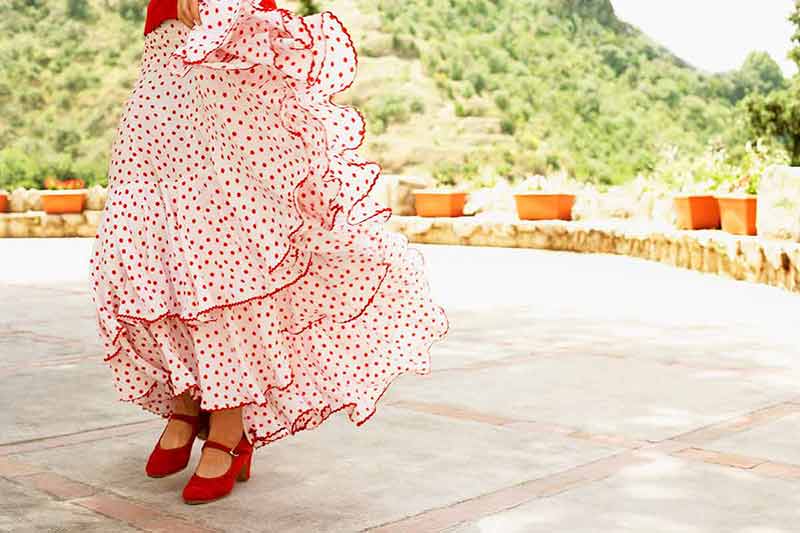
As the birthplace of Flamenco, the perfect place to enjoy this unique music and dancing is in Granada.
Many bars and restaurants feature live shows every night.
To experience the true origin of Flamenco, visit a performance in a cave restaurant or theatre.
The dramatic dancing and guitar strumming create an exciting atmosphere filled with people clapping and smiling.
Sacromonte offers perhaps the best location to see Flamenco performers, day and night.
In the Albaicín neighbourhood, people usually perform near the Mirador de San Nicolas.
Recommended shows:
15- See The Amazing Architecture of Monasterio De La Cartuja
One of the finest examples of Spanish Baroque architecture, the Monasterio de la Cartuja boasts an incredible interior despite its rather average exterior.
Works began in 1506 to create this wonder but were not completed until three centuries later.
The columns and ceiling offer incredibly intricate designs, and Juan Sánchez de Cotán created the marble sculptures and paintings.
The monastery is located just outside Granada, about 30 minutes on foot.
Monasterio de la Cartuja is at P.º de Cartuja, s/n, 18011 Granada.
16- Relax In Carmen De Los Mártires Gardens
Looking for some peace and tranquillity? Then spend a lovely afternoon relaxing in Carmen de los Mártires.
Beautiful gardens and walkways surround this wonderful 19th-century residence near the Alhambra.
This 7-hectare (2.5 acres) park usually doesn’t see many tourists.
The gardens are distinctly split into two parts.
One section displays a French baroque design, with a large pond and a statue of Neptune.
The English part features palm trees, hedges, and a three-story fountain.
Interestingly the two parts connect through a labyrinth inspired by the Nasrid period.
Swans and ducks swim around the large ponds in the park and occasionally, you can see peacocks as well!
Carmen de los Mártires is at P.º de los Mártires, s/n, 18009 Granada.
Recommended tour: Granada: Gardens of Carmenes Guided Tour
17- See The Renaissance Architecture of Monasterio De San Jerónimo
The complex and ornate decorations of the interior of the Royal Monastery of St. Jerome make it one of the most outstanding examples of Renaissance architecture, and it’s well worth seeing!
During the reconquest of Granada, King Ferdinand and Queen Isabella began constructing this masterpiece in 1492.
It was later moved to a new location and rebuilt by the monks in the early 16th century.
The monastery features two cloisters, each surrounding a garden.
The first cloister, with 36 semicircular arches, has shields with initials for all the kings.
The second courtyard displays a Gothic style of architecture.
The monastery pays tribute to the Great Captain Gonzalo Fernández de Córdoba for his heroic military accomplishments.
The luxurious columns and ceiling captivate visitors for hours with stunning artistic designs.
The Royal Monastery of St. Jerome is at C. Rector López Argüeta, 9, 18001 Granada.
18- Learn About Lorca At Huerta De San Vincent
Travel back in the past and visit the main residence of Federico García Lorca at the Huerta de San Vicente.
He completed many famous works such as Yerma, Blood Wedding, and Lament.
He is known as one of the most famous writers in Spain.
It was the family’s summer home, and now this preserved farmhouse and museum shares his life with the world.
It remains in its original form, unchanged from when he was alive.
You can see his personal belongings, painting, photographs, and manuscripts inside.
The museum sheds light on his most famous works, troubled life, criticism, and assassination.
Huerta de San Vicente is located at Casa-Museo Federico García Lorca, C.
Virgen Blanca, s/n, 18004 Granada.
19- Visit the Basílica De San Juan De Dios
One of the most impressive churches in Granada, the Basílica de San Juan de Dios, will not disappoint.
Don’t be fooled by the somewhat normal exterior facade; the true treasure lies within.
As you look up in all directions, it seems the entire interior is made of gold.
The paintings on the ceiling are just as impressive.
This Baroque church, built between 1737 and 1759, is dedicated to the patron saint of Granada, ‘John of God’.
San Juan de Dios dedicated his life to caring for the sick.
His tomb lies covered in decorations and candles.
The alcove above the basilica houses his personal belongings, including a wooden cross he always carried with him.
Basílica de San Juan de Dios is located at C/ San Juan de Dios, 17, 18001 Granada
20- See Street Art in Realejo ‘Jewish Quarter’
The most vibrant part of Granada is called Realejo, also known as the ‘Jewish Quarter’.
Incredible street art covers the walls of a part of the city that is a bit run down.
The famous artist Raul Ruiz “El Niño’ created many of these works.
This hip and trendy neighbourhood offers more than just art.
Try out some delicious Andalucian tapas as you take a stroll admiring the impressive and colourful graffiti.
Take a quick look inside the Santo Domingo Iglesia while you wander.
You can walk to Realejo from the Alhambra through small winding streets.
Don’t miss out on some of Spain’s best street art ever!
Recommended tours:
Love Spain? Read these posts:
- 27 Spanish Shows On Netflix
- 20 Fairytale Castles In Spain
- 30 Landmarks in Spain
- 20 Places To Visit In Spain In Winter
- 20 Best Beaches In Spain
- An Amazing Andalusia Road Trip
- 20 Things To Do In Ibiza
- 20 Things To Do In Tenerife
- 21 Things To Do In Lanzarote
- 21 Spanish Drinks To Try
- 20 Things To Do In Madrid At Night
- 20 Day Trips From Madrid
- Best Time To Visit Spain
- 20 Cities in Spain
- Renting A Car In Barcelona
- 20 Things To Do In Seville
- 20 Things To Do In Granada
- 20 Things To Do In Zaragoza
- 20 Things To Do In Palma
- 20 Tours In Spain
- 20 Things To Do In Alicante
- 20 Spanish Food / Dishes
- 20 Things To Do In Ronda
- 20 Things To Do In Cadiz
- 20 Thing To Do In Benalmadena
- 20 Things To Do In Torremolinos
- 20 Landmarks In Barcelona
- 5 Day Trips From Barcelona
- Barcelona Bike Tour
- 10 Things To Do In Bilbao
- 12 Things To Do In San Sebastian
- 10 Things To Do In Oviedo
- Storybook Village of Santillana del Mar
- 20 Things To Do In Gran Canaria
- 20 Things To Do In Barcelona At Night
- Christmas in Spain
- 20 Things To Do In Malaga
- 20 Things To Do In Marbella
- 20 Things To Do In Valencia
- Where To Stay In Valencia
- Ibiza At Night
- 20 Things To Do In Ibiza
- 20 Things To Do In Toledo
- Where To Stay in Barcelona
- 20 Things To Do In Segovia
- Where To Stay in Tenerife
- Where To Stay in Madrid
- Where To Stay In Mallorca
- Where To Stay In Ibiza
- 15 Things Spain Is Famous For
Plan Your Trip

Rent A Car – Find the best car rental rates at Discover Cars. They compare car hire companies to provide you with the best deal right now.

Find A Hotel – If you’re curious about this article and are looking for somewhere to stay, take a look at these amazing hotels.

